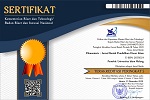PENGEMBANGAN LKS ILMU PENGETAHUAN ALAM KELAS 4 MELALUI PENDEKATAN INTEGRASI AL-ASMA' AL-HUSNA
DOI:
https://doi.org/10.33474/elementeris.v3i2.10951Abstract
The development of students' worksheets of science with Al-Asma’ Al-Husna approach was based on the need for students’ worksheets with Al-Asma’ Al-Husna integration as one of students' learning resources. This research aims to fulfill student worksheets' availability to increase elementary school students' effectiveness. The purpose of this research was to produce students' worksheets of science for 4th grade by Al-Asma’ Al-Husna integration approach. This study used the development research method. According to the validators' assessment, the result of validation by matter experts was in good qualifications, the result of validation by design expert was also in good qualifications. The attractiveness assessment by students shows the results that the students’ worksheet was interesting. Meanwhile, the test results were carried out using the pre-test and post-test methods which showed a positive effect. Overall, the science students' worksheets were included in both qualifyings so fit for science teaching for fourth grade in elementary school.References
Anggraini, R., Wahyuni, S., & Lesmono, A. D. (2016). Pengembangan lembar kerja siswa (Lks) berbasis keterampilan proses di SMAN 4 Jember. Jurnal Pembelajaran Fisika, 4(4), 350–365.
Bahri, S., & Nidal, A. (2019). Human Communication with God through Al-Asma’ Al-Husna (99 Names of Allah)(Study of Al-Asma’ Al-Husna’s Understanding in Islamic Theology). Britain International of Humanities and Social Sciences (BioHS) Journal, 1(2), 140–148.
Fannie, R. D., & Rohati, R. (2014). Pengembangan lembar kerja siswa (LKS) berbasis POE (predict, observe, explain) pada materi program linear kelas XII SMA. Sainmatika: Jurnal Sains Dan Matematika Universitas Jambi, 8(1), 221053.
Hamdu, G., & Agustina, L. (2011). Pengaruh motivasi belajar siswa terhadap prestasi belajar IPA di sekolah dasar. Jurnal Penelitian Pendidikan, 12(1), 90–96.
Latifah, S., Hidayah, N., Shawmi, A. N., Amrullah, M. A., & Fitriana, N. S. (2019). Snake and ladder game integrated with Asmaul-Husna: Development of learning media. Journal of Physics: Conference Series, 1155(1), 012024. IOP Publishing.
Nannyonjo, H. (2007). Education inputs in Uganda: An analysis of factors influencing learning achievement in grade six. The World Bank.
Pribadi, B. A. (2010). Model Desain Sistem Pembelajaran. Jakarta: Dian Rakyat.
Rosmani, A. F., & Zakaria, M. (2018). Al-Asma’ Al-Husna Learning through Gamifications and Adaptation of Signalling Principle. Journal of Physics: Conference Series, 1019(012080), 1–7.
Sadjati, I. M. (2012). Pengembangan bahan ajar.
Saleh, I., & Kim, S. (2009). A fuzzy system for evaluating students’ learning achievement. Expert Systems with Applications, 36(3), 6236–6243.
Setyosari, H. P. (2016). Metode penelitian pendidikan & pengembangan. Jakarta: Kencana Prenada Media.
Sugiyono. (2009). Metode Penelitian Pendidikan Pendekatan Kuantitatif, Kualitatif, dan R&D. Bandung: Alfabeta.
Sukmadinata, N. S. (2008). Metode Penelitian Pendidikan. Bandung: Remaja Rosdakarya.
Widjajanti, E. (2008). Kualitas lembar kerja siswa. Makalah Seminar Pelatihan Penyusunan LKS Untuk Guru SMK/MAK Pada Kegiatan Pengabdian Kepada Masyarakat Jurusan Pendidikan FMIPA Universitas Negeri Yogyakarta, 2–5.
Downloads
Published
Issue
Section
License
The journal operates an Open Access policy under a Creative Commons Non-Commercial 4.0 International license. Authors who publish with this journal agree to the following terms:
- Authors retain copyright and grant the journal right of first publication with the work simultaneously licensed under a Commons Attribution-NonCommercial 4.0 International License
that allows others to share — copy and redistribute the material in any medium or format, and adapt — remix, transform, and build upon the material.
- Authors are able to enter into separate, additional contractual arrangements for the non-exclusive distribution of the journal's published version of the work (e.g., post it to an institutional repository or publish it in a book), with an acknowledgement of its initial publication in this journal.
- Authors are permitted and encouraged to post their work online (e.g., in institutional repositories or on their website) prior to and during the submission process, as it can lead to productive exchanges, as well as earlier and greater citation of published work.
Elementeris: Jurnal Ilmiah Pendidikan Dasar Islam by Universitas Islam Malang is licensed under a Creative Commons Attribution-NonCommercial 4.0 International License.
Based on a work at http://riset.unisma.ac.id/index.php/je/index.















